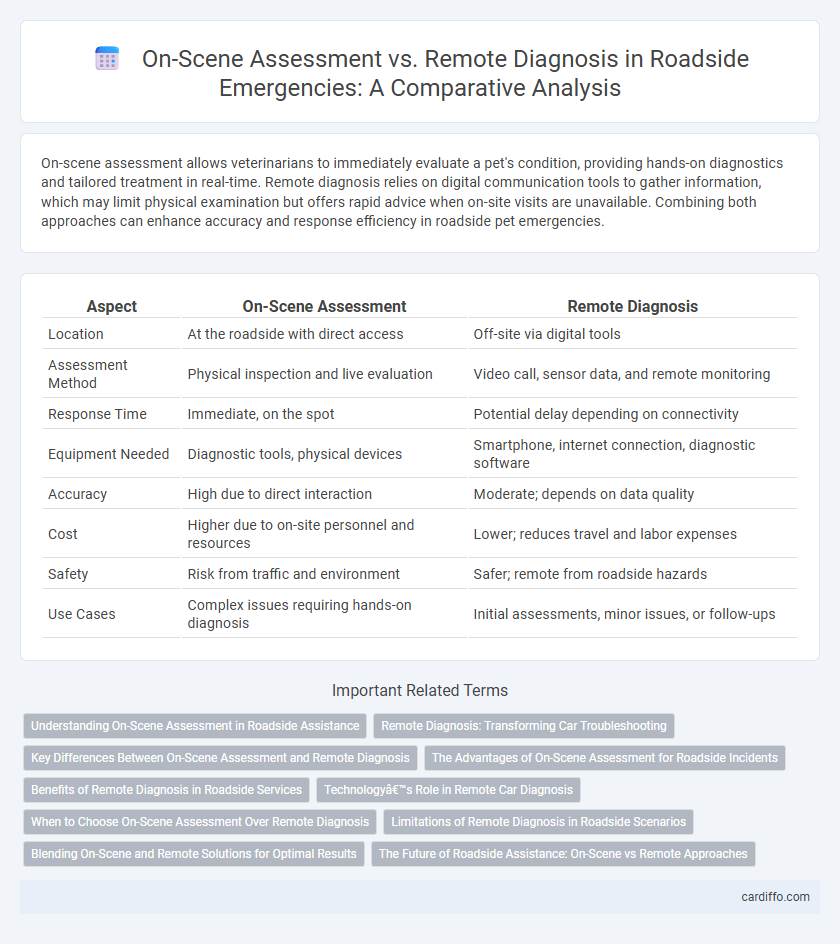On-scene assessment allows veterinarians to immediately evaluate a pet's condition, providing hands-on diagnostics and tailored treatment in real-time. Remote diagnosis relies on digital communication tools to gather information, which may limit physical examination but offers rapid advice when on-site visits are unavailable. Combining both approaches can enhance accuracy and response efficiency in roadside pet emergencies.
Table of Comparison
| Aspect | On-Scene Assessment | Remote Diagnosis |
|---|---|---|
| Location | At the roadside with direct access | Off-site via digital tools |
| Assessment Method | Physical inspection and live evaluation | Video call, sensor data, and remote monitoring |
| Response Time | Immediate, on the spot | Potential delay depending on connectivity |
| Equipment Needed | Diagnostic tools, physical devices | Smartphone, internet connection, diagnostic software |
| Accuracy | High due to direct interaction | Moderate; depends on data quality |
| Cost | Higher due to on-site personnel and resources | Lower; reduces travel and labor expenses |
| Safety | Risk from traffic and environment | Safer; remote from roadside hazards |
| Use Cases | Complex issues requiring hands-on diagnosis | Initial assessments, minor issues, or follow-ups |
Understanding On-Scene Assessment in Roadside Assistance
On-scene assessment in roadside assistance involves a technician physically inspecting the vehicle to identify mechanical issues, evaluate the environment, and apply immediate solutions. This direct interaction allows for accurate diagnostics based on visual cues, sensor readings, and client feedback, leading to quicker and more reliable repairs. Understanding on-scene assessment improves the efficiency of roadside services by minimizing diagnostic errors and optimizing resource allocation.
Remote Diagnosis: Transforming Car Troubleshooting
Remote diagnosis leverages advanced telematics and AI-powered analytics to accurately identify vehicle issues without requiring physical presence, significantly reducing response times and repair costs. Real-time data transmission from onboard sensors enables technicians to monitor engine performance, battery status, and fault codes remotely, facilitating faster decision-making and optimized repair strategies. This technology enhances roadside assistance by providing immediate diagnostic insights, improving vehicle safety and driver confidence during roadside emergencies.
Key Differences Between On-Scene Assessment and Remote Diagnosis
On-scene assessment offers real-time, direct evaluation of vehicle conditions through physical inspection and immediate driver interaction, enabling quicker decision-making for roadside assistance. Remote diagnosis utilizes telematics and data analytics to identify issues from a distance, relying on sensor data and automated reports, which can expedite fault detection without the need for physical presence. Key differences lie in the immediacy and depth of hands-on inspection in on-scene assessments versus the convenience and data-driven approach of remote diagnosis.
The Advantages of On-Scene Assessment for Roadside Incidents
On-scene assessment provides immediate, real-time evaluation of roadside incidents, enabling accurate damage appraisal and prompt decision-making. This approach minimizes diagnostic errors often associated with remote evaluations by allowing direct inspection of vehicle condition and environmental factors. Rapid on-site diagnosis enhances safety for both responders and motorists, reducing incident response time and facilitating faster recovery.
Benefits of Remote Diagnosis in Roadside Services
Remote diagnosis in roadside services enables faster identification of vehicle issues by transmitting real-time data to expert technicians, reducing wait times and improving service efficiency. This technology minimizes the need for on-scene physical inspections, allowing tow and repair services to be better prepared with necessary parts and tools upon arrival. Enhanced diagnostic accuracy through remote systems decreases roadside downtime and increases overall customer satisfaction.
Technology’s Role in Remote Car Diagnosis
Remote car diagnosis leverages advanced telematics and onboard sensors to provide real-time data on vehicle health without physical inspection, enabling faster identification of issues. Diagnostic software platforms utilize machine learning algorithms to interpret error codes and sensor inputs, facilitating accurate troubleshooting from a distance. This technology minimizes the need for towing or on-scene assessment, reducing response time and improving roadside assistance efficiency.
When to Choose On-Scene Assessment Over Remote Diagnosis
On-scene assessment is crucial when immediate physical inspection is necessary to accurately diagnose vehicle issues, especially in cases involving visible damage, fluid leaks, or safety hazards. It allows technicians to perform hands-on evaluations, use specialized tools, and gather real-time data that remote diagnosis cannot capture. Opt for on-scene assessment when remote diagnosis lacks sufficient data or when precise calibration and physical intervention are required to resolve complex roadside problems efficiently.
Limitations of Remote Diagnosis in Roadside Scenarios
Remote diagnosis in roadside scenarios often faces limitations due to inconsistent cellular connectivity and varying environmental conditions, which can hinder real-time data transmission and accurate vehicle assessment. The lack of direct physical inspection restricts the ability to detect mechanical nuances or subtle damages, reducing diagnostic precision. Furthermore, reliance on driver-reported symptoms during remote evaluation increases the risk of misinterpretation and delayed or inappropriate interventions.
Blending On-Scene and Remote Solutions for Optimal Results
Blending on-scene assessment with remote diagnosis enhances roadside assistance by combining real-time visual inspection and expert analysis through digital tools, ensuring swift and accurate vehicle condition evaluation. This hybrid approach leverages advanced telematics and mobile connectivity to facilitate immediate troubleshooting while enabling specialists to guide on-site technicians efficiently. The integration of both methods optimizes resource allocation, reduces response times, and improves overall customer satisfaction in roadside service operations.
The Future of Roadside Assistance: On-Scene vs Remote Approaches
On-scene assessment in roadside assistance ensures immediate, hands-on evaluation with precise diagnostics, leveraging advanced tools like OBD-II scanners and thermal imaging for efficient repairs. Remote diagnosis utilizes connected vehicle technology and telematics to analyze vehicle data in real-time, enabling experts to guide drivers through troubleshooting or dispatch help faster. The future of roadside service is likely a hybrid model, combining the accuracy of on-scene assessments with the speed and scalability of remote diagnostics to enhance response times and repair effectiveness.
On-Scene Assessment vs Remote Diagnosis Infographic

 cardiffo.com
cardiffo.com